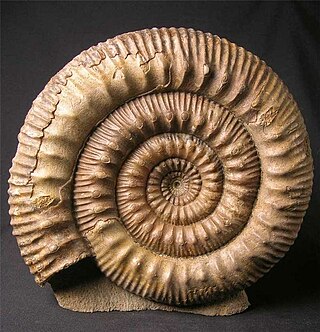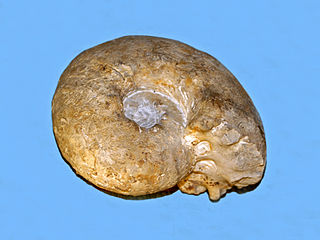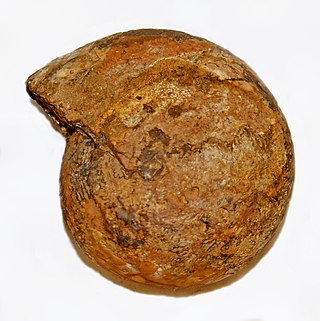
Stephanoceras is an extinct genus of Stephanoceratoid ammonite which lived during the Bajocian. It is the type genus of the family Stephanoceratidae.

Acanthohoplites is an extinct genus of ammonites in the family Parahoplitidae that lived in the Aptian and Early Albian stages of the Early Cretaceous.

Xipheroceras is a Lower Jurassic ammonite belonging to the Eoderoceratidae, and sometimes placed in the subfamily Xipheroceratinae for which it is the namesake. It has been found in the upper Sinemurian of Europe and possibly Borneo.

Alsatites is an extinct genus of cephalopod belonging to the Ammonite subclass. They lived during the Hettangian and are generally extremely evolute, many whorled. Keel broad and blunt organisms, they also exhibit a primary ribbing which is close and persistent.

Aspidoceras is an extinct ammonoid cephalopod genus belonging to the family Aspidoceratidae.
Balticeras is an involute, discoidal Upper Jurassic (Oxfordian) ammonite found in England, Germany, and Switzerland, belonging to the Perisphinctidae. The shell is strongly embracing, tending to be oxyconic. Sides are gently curved, converging on a narrow to sharp ventral rim.
Bifericeras is a Lower Jurassic ammonite belonging to the family Eoderoceratidae, and sometimes placed in the subfamily Xipherceratinae. Whorls are strongly depressed, but still evolute in coiling. The early growth state is prolonged, and smooth, followed by a late growth stage with rounded, straight, bituberculate ribs.
Unipeltoceras is an extinct ammonite genus included in the perisphictacian family, Aspidoceratidae, and a member of the subfamily Peltoceratinae, that lived during the Callovian stage, late in the Middle Jurassic.
Euaptetoceras is an evolute hildoceratoid ammonite from the lower Middle Jurassic, included in the family Hammatoceratidae and the subfamility Hammatoceratinae. The genus may be a junior synonym for Eudmetoceras of Buckman, 1920.
Oecoptychius is an extinct genus of fossil ammonite cephalopods. The species lived during the Middle Jurassic.
Lissoceras is an involute, smooth or finely vetrolaterally ribbed, ammonite with a blunt, un-keeled venter, included in the Haploceratidae, that lived from the Lower Bajocian - Middle Oxfordian in what is now Europe, south Asia, and southern Alaska.

Nostoceras is an extinct genus of ammonites. The etymology of the name Nostoceras comes from "nostos" meaning return and "ceros" meaning horn, named as such by Alpheus Hyatt because it bends back on itself.

Peltoceras is an extinct ammonite genus from the aspidoceratid subfamily Peltoceratinae that lived during the later part of the Middle Jurassic.

Oxynoticeratidae is a family of true ammonites included in the superfamily Psiloceratoidea.
Eoderoceras is an evolute, round whorled ammonite from the Lower Jurassic with an outer row of distinct spines, and in some, an inner row of tubercles, on either side; ribs only on the inner whorls.
Haploceras is a genus of late Upper Jurassic ammonoid cephalopods and the type for the Haploceratidae, similar to Lissoceras but with a broader whorl section and small blunt lappets and a blunt rostrum; some species with feeble ventral folds on body chamber.

Kepplerites is a moderately evolute ammonite from the lower Callovian included in the Stephanoceratoidea.
Dipoloceras is a rather evolute, strongly ribbed and well keeled acanthocerataean ammonite from the Albian stage of the Lower Cretaceous included in the brancoceratid subfamily Mojsisovicziinae. The whorl section is typically inflated or depressed. Ribs are high standing, may be sharp, close to wide spaced. The ventral keel may sit below the level of the ribs.

Orthaspidoceras is an extinct ammonoid cephalopod genus belonging to the family Aspidoceratidae. These nektonic carnivores lived during the Jurassic period, Kimmeridgian age.

Halorites is an extinct genus of Triassic ammonoids belonging to the family Haloritidae.











